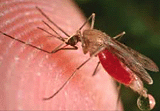Malaria ~ Little Parasite, Big Consequences |
 * Malaria is caused by the parasite Plasmodium falciparum, which is transmitted by the female Anopheles mosquito. * Plasmodium settles in the red blood cells of the human host, where it then multiplies and hinders erythropoiesis,the making of new red blood cells (Stolzfus). *Malaria generally occurs in tropical and subtropical areas. Approximately 40% of the world is at risk, while 80% of cases occur in Africa (Francis). Symptoms: * Often, malaria is asymptomatic in the early stages. Symptoms can also be nonspecific, and difficulty diagnosing is common in non-prevalent regions. * Some people native to where the disease is prevalent acquire a natural immunity, however those without any immune defense are the most at risk for death. For this reason, children who have not yet built an immunity have the highest fatality rates. * The disease can greatly damage the nervous system, liver, and kidney. * Death can occur within hours. Severe outcomes include acute renal failure, respiratory distress, severe anemia, and death from cerebral malaria.
For a description regarding the ways in which Plasmodium falciparum has adapted to treatments and control techniques click HERE
|
| All references for this page come from MVI, unless otherwise noted. |